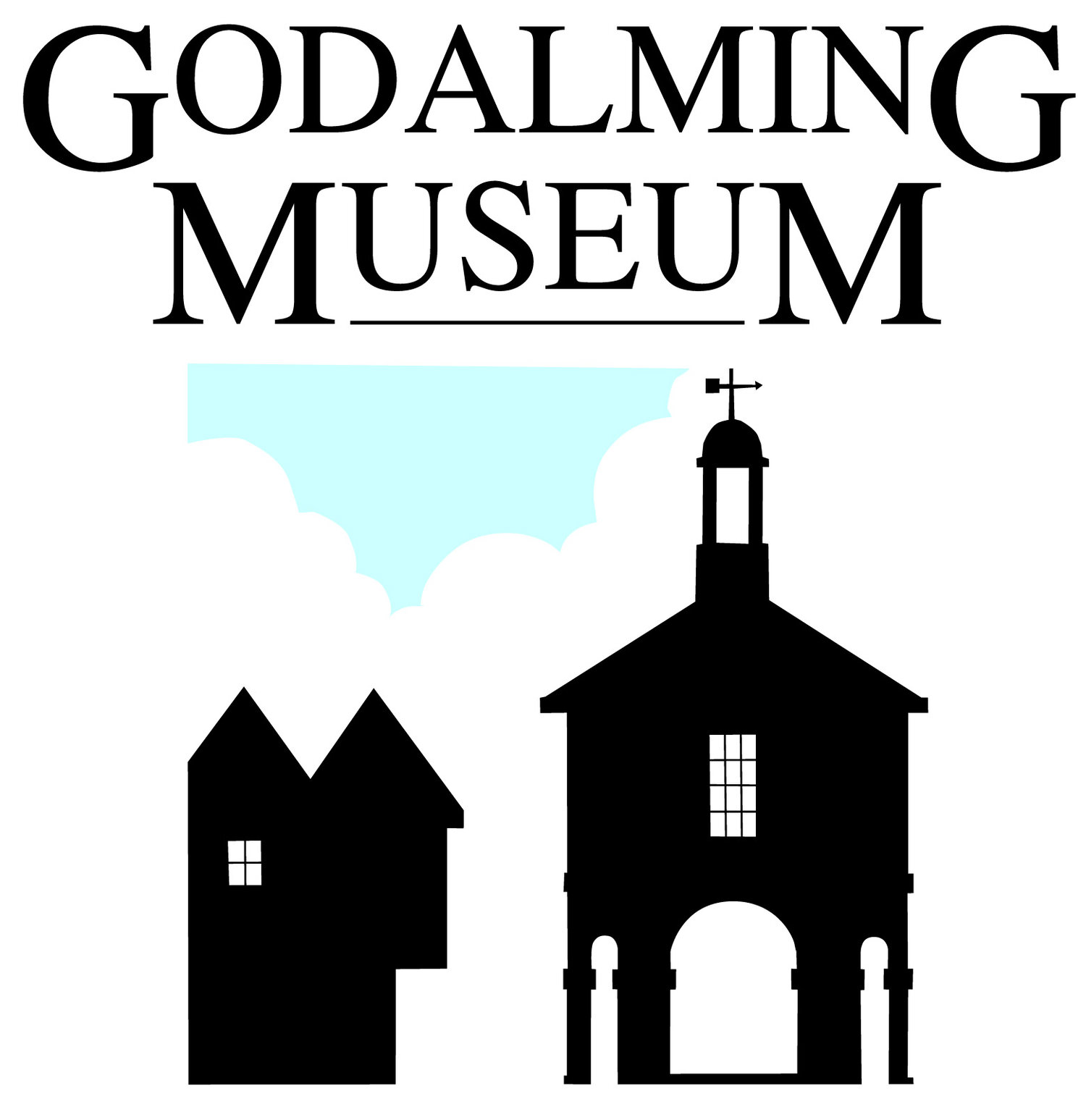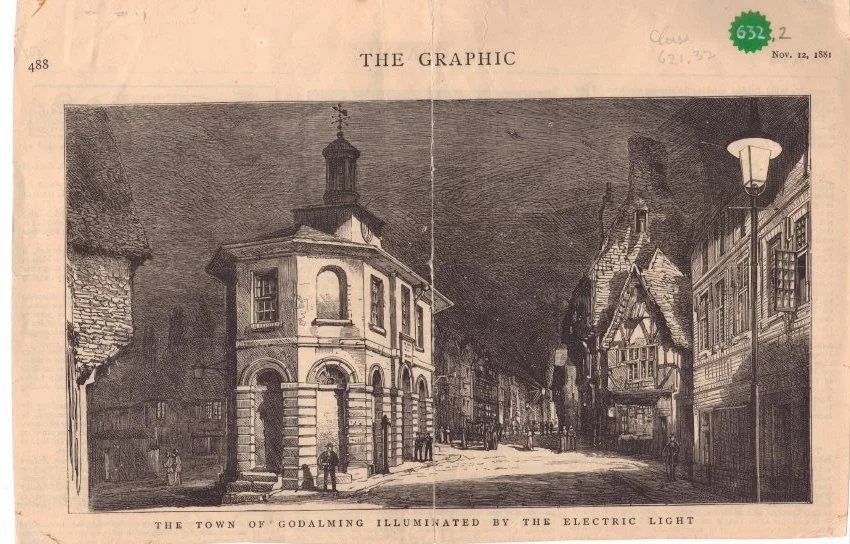Godalming & Electricity
In 1881, Godalming had electric street lighting and public electricity in people’s houses. It was not the first place to have electric street lighting but it was the first place in the world to have public electricity. This plaque is on the open ground floor of the Pepperpot and reads:
“THIS PLAQUE COMMEMORATES THE
WORLD’S FIRST PUBLIC ELECTRICITY SUPPLY
ON 26TH SEPTEMBER 1881
.
NEAR THIS SPOT WAS INSTALLED THE FIRST
ELECTRIC LAMP TO LIGHT THE PUBLIC HIGHWAY
UNDER THIS PIONEERING DEVELOPMENT
.
THIS PLAQUE WAS UNVEILED ON THE CENTENARY OF THIS EVENT
BY JOHN WEDGWOOD CHAIRMAN OF THE SOUTHERN ELECTRICITY BOARD”
On the 3rd September 1881 the Godalming Borough Lighting Committee “had under their consideration the desirability of lighting the Borough by electricity, and with this in view have made arrangements with a London firm of electricians to fix two or three electric lights as an experiment.”
The Surrey Advertiser of 1st October 1881 (Saturday) reported, “On Monday evening (the 26th September) the upper portion of the Borough of Godalming was lighted by electricity for a few hours as an experiment and continued each night since, the motive power to generate the current being an auxiliary face water-wheel at the Westbrook Mills, of Messrs. Pullman brothers, the skin dressers, who have made arrangements for lighting their mills with the Swan lights, and for the larger open spaces with Siemen’s differential lamps of 300 candle-power each.” In 1879 Sir Joseph Wilson Swan had invented the incandescent light where a filament was inside a vacuum sealed bulb which gave about 30 candle-power.
The Surrey Advertiser reported the Mayor (Alderman Eager) and members of the council had visited Messrs Pullman’s Mills to see the machinery at work.” Edward Eager (1842-1907) was a JP and the mayor elect from 9th November 1880-1. He lived in the High Street but by 1883 had moved to Sussex.
Photographic portrait of Edward Eager, Godalming Museum Collection B011.97.15
Street Lights
The Surrey Advertiser also reported that three Siemen’s lights had been erected in the town, on iron poles 22 feet high, one in Deanery Place opposite the vicarage, another on the south-side of the Town Hall (then held in the Pepperpot) to light Ockford Road (which at this time included the Upper High Street) and the third opposite the Town Clerk’s office. Godalming was not the first place in the world to have electric street lighting, but, as the plaque goes on to explain, it was the first to provide electric lighting both in houses and in streets. News reached as far afield as Bristol where The Bristol Mercury & Daily Post of the 29th September reported the experiment to light part of Godalming by electricity generated by a water wheel.
A black and white image was printed in The Graphic on the 21st November 1881. They reported that Godalming was the first town in England to substitute the electric light instead of gas for lighting its public streets. However no mention was made of the public electricity supply to houses.
Streets had been lit up in Paris, London and San Francisco before Godalming’s lights. On the 18th September 1879 Blackpool promenade pier was lit by six Siemens lights and the electric light had been introduced on 28th October to the British Library reading room.
From 19-26th September 1981 the Southern Electricity Board and the Electricity Council held a week of celebrations to celebrate the 100th anniversary. In J.E. Harris A Century of Electricity Supply CEGB 1981, it was noted, “The answer is simply that at Godalming, a central station not only supplied power for a specific purpose, the lighting of the streets, but also for the very first time offered electricity for sale to any individual member of the general public who desired it.”
Public Electricity
The Surrey Advertiser reported that by adopting electric lighting any of the inhabitants would be given the opportunity of having it introduced into their shops and dwellings. One of the key people in setting up the scheme was Stephen Tanner. He was among one of the first customers for the public electricity. He was a draper and outfitter and his shop which has since been demolished stood where the Slug and Lettuce now stands (2014). He was mayor in 1885. The Swan United Electric Light Company Limited’s Illustrated Catalogue of 1883 gives a list naming the Swan Lamps which had been fitted. Included with the ‘town of Godalming’ were Godalming names; Mr Tanner, Mr Ballard, Mr Burgess, Mr Collier and Mr Barnes. Sydney Ballard was a draper and clothier and mayor in 1886, Charles Burgess was a grocer and mayor in 1884, John Cates Collier was a bank manager and mayor in 1892.
Water Power
The Town Council reported that “after full investigation ultimately they agreed with Messrs Calder and Barrett, to light the Town by Electricity for the 12 months commencing the 1st October for £195.” Messrs Calder and Barrett were based at 154, Westminster Bridge Road and had introduced electric light into the British Museum. The power was generated at Westbrook Mill (formerly Salgasson Mill), the tannery owned by R & J Pullman on the River Wey. Water on a side channel turned the two Poncelet waterwheels to drive a Siemens alternate current dynamo machine generator. The French designed Poncelet waterwheel had been in use since 1838 and was twice as efficient as undershot waterwheels. Initially floods presented a problem and back water caused insufficient revolutions of 700 to be made and to overcome this a 10-horse power steam engine had been brought into use made by Messrs Wallis and Steevens, engineers of Basingstoke.
A contract had been made between the Town Council and Pullmans tannery that in compensation for the use of their water rights, they would be given lights for the yards, factory buildings and Mr J Pullman’s house. Pullmans business included the preparation of chamois, buckskin, and saddle leather and they undertook Government contracts. To have the mills and yards lit day and night for the men to work by was a great advantage and by the 16th December 1881 The Times reported that Pullmans had three arc lights and fifteen Swan lamps lighting the mills.
The Times reported that in Godalming, branching off from seven arc lights (three in the town) were overhead bare copper wires attached by insulators to poles for 40 Swan incandescent lights which burnt in the minor streets. The incandescent lights were in pear shaped lanterns which had been placed into the ordinary gas lamps. The arc lights were enclosed in square lanterns of clear glass and gave out more light than the Swan lights. It involved two circuits and in total covered about 5 miles. In Engineering of the 13th January 1882 it was stated that Pullmans had three arc lights and seven incandescent lights and the town had four arc lights and 27 incandescent lights. The arc lights gave at least 300 candle-power whilst the Swan lights gave about 30 candle-power.
Gas
The Godalming Gas and Coke Company supplied gas to the town from the winter of 1836/7 but after many years lighting the town the councillors made the decision to change from gas to electricity. A price war between the two meant new contracts were considered. The new contract for Electricity which dated from the 1st October 1881 was 19% cheaper than the cost of lighting the town by gas.
In January 1882 Siemens agreed to light the town by transferring the generating plant from Pullmans mill to the town and laid the main cables in the gutters. George Stephen Tanner (1868-1954) recorded his reminiscences and wrote “When the floods came it upset in some way the water power and so the dynamos were taken to a shed at the back of the old White Hart and an ordinary traction engine used with a wide strap on its wheel to connect to the dynamo. There was a very nice German (Edward Friedrich Herman Henrich Lauckert) here to look after the technical side”. On the 18th August 1882 a new Electric Lighting Act was introduced giving powers to break up the streets to lay cables. Siemens continued their annual contract to operate without laying cables in gutters until 1884. Alexander Siemens reviewed the private sales when he had about a dozen consumers with 160 lamps but needed 400-500 private lights to make it economic and according to the Electrician in April 1884 “was not prepared to tender on a year-to-year basis to gain experience…. except on a legal footing”. The electricity supply proved too expensive and the local gas company tendered a cheaper cost to light the town. Gas returned as the source of lighting on the 1st May 1884.
On the 4th February 1902 the Town Council was in communication with the Urban Electric Supply Company (which had opened in Borough Road in 1902) who had submitted a tender. They offered to fit incandescent electric lamps holding 25 candle-power and to maintain the 236 lamps in the Borough for £649 per annum, burning from half-an-hour after sunset to 12 o’clock at night at a rate of £2 15s per 25 candle-power lamp. Lighting per half night by gas was £893, while electricity at 25 candle-power was £649. The present contract with the Gas Company was until 1st January 1903 and until then the number of lamps lighted by gas was to be reduced to 150. The committee recommended that 86 of the public lights be lighted by electricity as soon as possible and that the Borough be lighted with lamps giving a minimum light of 25 candle-power, and the agreement with the Godalming Gas Company be terminated as from 1st January 1903.
On the 6th May 1902 there were visits to Sandown, Shanklin and Ventnor on the Isle of Wight to inspect their lighting. A scheme was accepted with 10 arc lamps of 750 candle-power each, 105 incandescent lamps of 50 candle-power each and 109 incandescent lamps of 25 candle-power each, to light the area at present served by 236 gas lamps. This came to a final cost of £793 15s 0d, just under £100 less than the gas price tendered. Electricity returned as the source of lighting in 1903. In 1902 the Urban Electric Supply Company Ltd opened its works in the Borough Road and advertised ‘mains laid in practically every road in the Borough’. So it would appear that the public had to wait for eighteen years after the first experiment before getting access to electricity again.
References
Electrician 1884 vol 12 no 5 p.485
Electricity Council 1973 A Electricity Supply in the United Kingdom A Chronology from the beginnings of the industry to 31st December 1985
Godalming Borough Council Records at Godalming Museum
Gravett, Kenneth 2008 The Electric Light at Godalming, 1881 from ‘Surrey History’ vol 2 no 3
Harris, J E 1981 A Century of Electricity Supply CEGB
Haveron, Francis 1981 The Brilliant Ray
The Graphic 21st November 1881
The Surrey Advertiser Saturday 1st October 1881
The Times 16th December 1881
Tucker, D G 1977 Hydro-Electricity for Public Supply in Britain 1881-1894 Industrial Archaeological Review vol 1 p126


